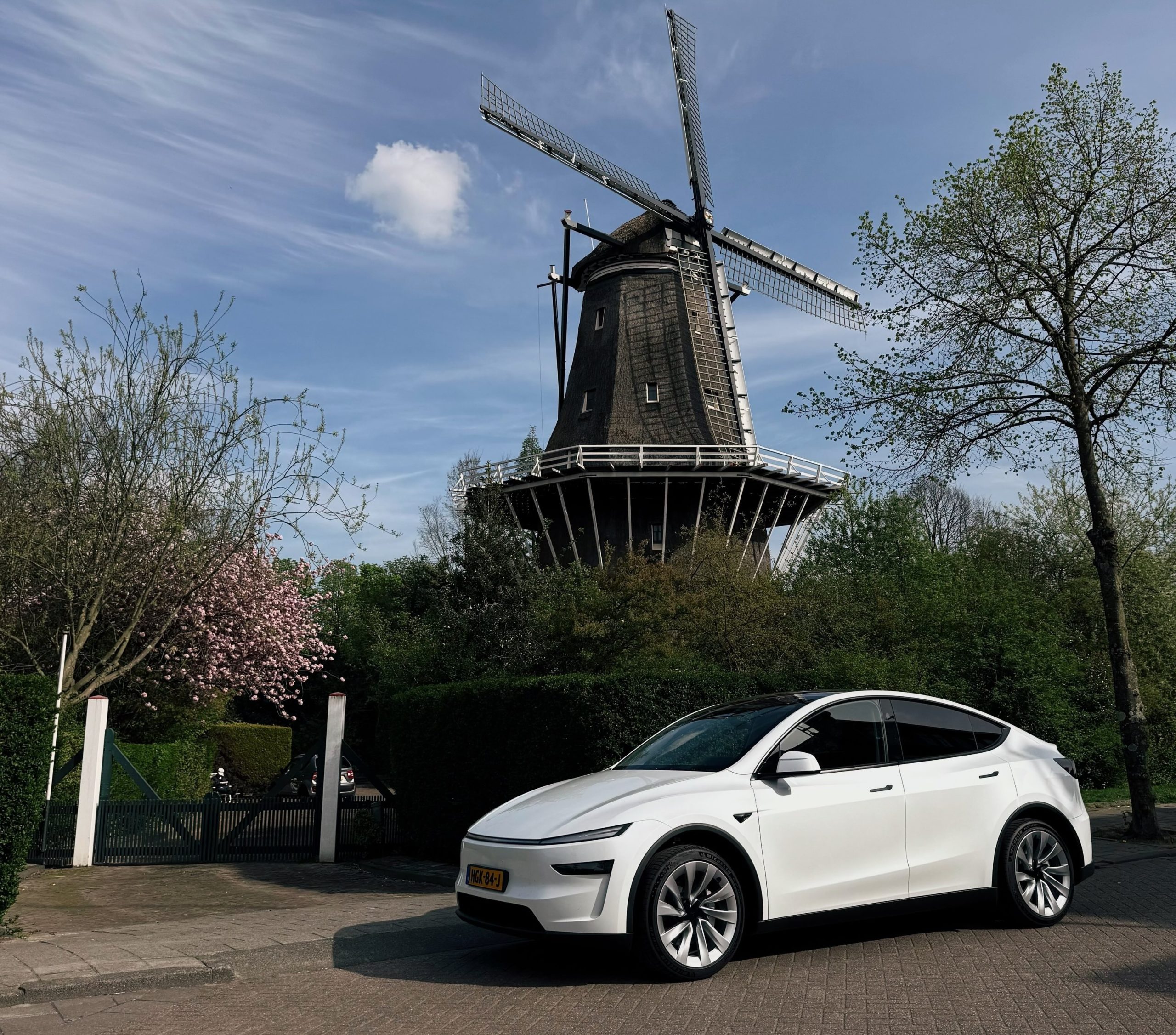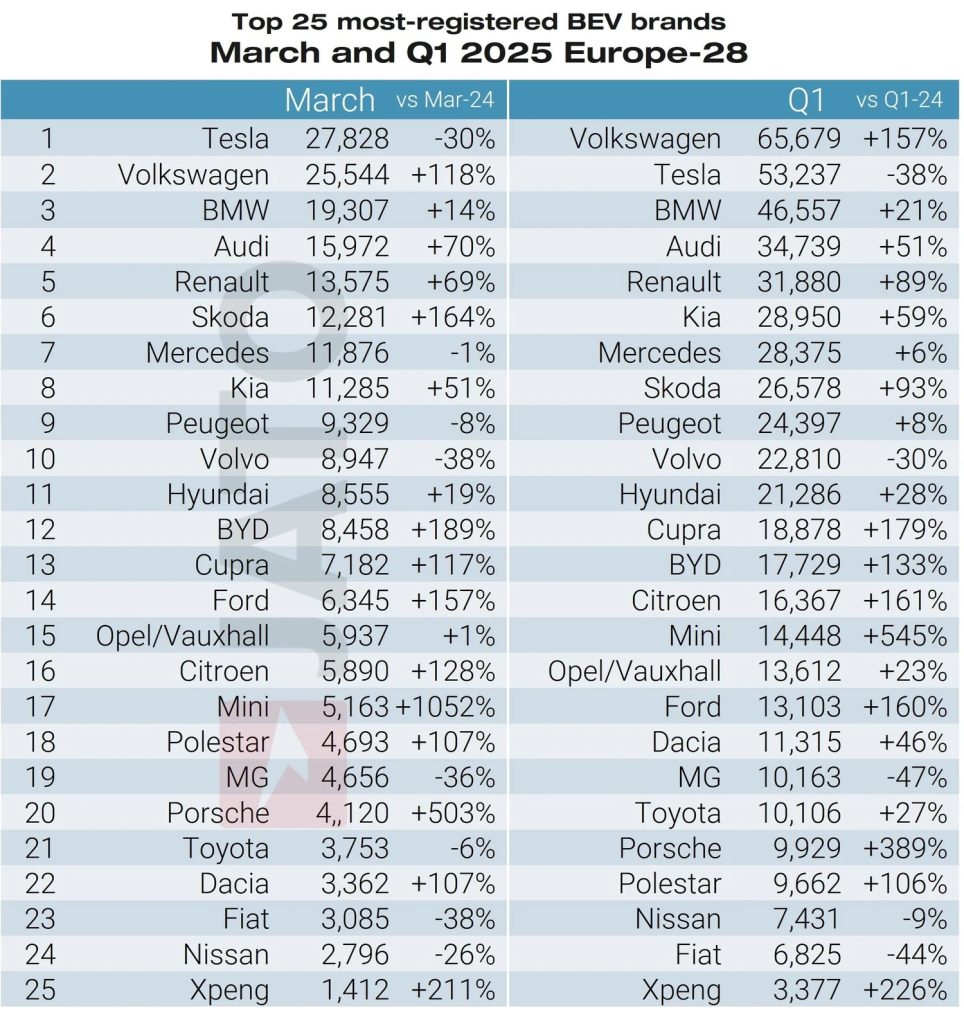News
Tesla Model Y and Model 3 still kings of Europe BEVs in March 2025: JATO
The Tesla Model 3 and Model Y remained the kings of Europe’s battery electric vehicle sector in March 2025.

Reports of Tesla’s death in Europe have been wildly exaggerated. This was recently highlighted by JATO Dynamics, which noted that Tesla’s decline in Europe actually slowed down in March.
As per JATO Dynamics data, the Tesla Model 3 and Model Y also remained the kings of Europe’s battery electric vehicle sector in March 2025.
Tesla Europe’s Q1 2025
Tesla’s decline in January and February 2025 in Europe has resulted in quite a lot of alarmist reports about the electric vehicle maker. While Tesla noted in its Q1 vehicle delivery report that its sales decline was mostly due to the changeover to the new Model Y, critics nonetheless argued that Tesla’s brand has been utterly destroyed by the politics of CEO Elon Musk.
A look at JATO’s recent report, however, suggests that Tesla is starting to show some recovery in Europe. While Tesla saw a 38% year-over-year decline in the first quarter overall, the company’s drop became less severe as the quarter ended. In January, Tesla Europe recorded a severe 47% drop, and in February, the company’s year-over-year decline dropped to 44%. In March, Tesla Europe’s year-over-year decline had dropped to just 30%.

Interestingly, Felipe Munoz, Global Analyst at JATO Dynamics, noted that the Tesla Model 3 became a valuable player in the company’s Europe numbers in March. “As the brand continues to deal with a host of PR issues in addition to the changeover of the Model Y, Tesla is now relying on the Model 3 to offset the losses,” Munoz stated.
Tesla Model Y and Model 3 Still Dominates
Granted, Tesla’s decline in the first quarter in Europe paved the way for Volkswagen to become the region’s top BEV seller for Q1. However, when it came to the sales of individual BEVs in the region, the Tesla Model Y and Model 3 remained unstoppable. What was especially interesting was the fact that the Model Y and Model 3 topped Europe’s battery electric vehicle rankings in March despite the vehicles seeing a year-over-year decline in sales.

The Model Y topped Europe’s best-selling BEV list in March with a total of 15,164 units sold. Following the Model Y was the Model 3, which saw a total of 12,500 units sold in March. The mass market Tesla siblings’ sales figures were notably higher than their closest competitors. The Volkswagen ID.4, which was ranked 3rd, only saw sales of 7,675 units, and the Volkswagen ID.7, the 4th-best-selling BEV in Europe in March, only sold 7,438 units during the month.
“Despite the controversy surrounding the brand’s CEO and the limited availability of the new Model Y, Tesla continues to perform well as the most popular EV brand in Europe. Its success, amid these challenges, provides an indication of what European consumers are looking for in an EV,” Munoz stated.

News
Tesla starts showing how FSD will change lives in Europe
Local officials tested the system on narrow country roads and were impressed by FSD’s smooth, human-like driving, with some calling the service a game-changer for everyday life in areas that are far from urban centers.

Tesla has launched Europe’s first public shuttle service using Full Self-Driving (Supervised) in the rural Eifelkreis Bitburg-Prüm region of Germany, demonstrating how the technology can restore independence and mobility for people who struggle with limited transport options.
Local officials tested the system on narrow country roads and were impressed by FSD’s smooth, human-like driving, with some calling the service a game-changer for everyday life in areas that are far from urban centers.
Officials see real impact on rural residents
Arzfeld Mayor Johannes Kuhl and District Administrator Andreas Kruppert personally tested the Tesla shuttle service. This allowed them to see just how well FSD navigated winding lanes and rural roads confidently. Kruppert said, “Autonomous driving sounds like science fiction to many, but we simply see here that it works totally well in rural regions too.” Kuhl, for his part, also noted that FSD “feels like a very experienced driver.”
The pilot complements the area’s “Citizen Bus” program, which provides on-demand rides for elderly residents who can no longer drive themselves. Tesla Europe shared a video of a demonstration of the service, highlighting how FSD gives people their freedom back, even in places where public transport is not as prevalent.
What the Ministry for Economic Affairs and Transport says
Rhineland-Palatinate’s Minister Daniela Schmitt supported the project, praising the collaboration that made this “first of its kind in Europe” possible. As per the ministry, the rural rollout for the service shows FSD’s potential beyond major cities, and it delivers tangible benefits like grocery runs, doctor visits, and social connections for isolated residents.
“Reliable and flexible mobility is especially vital in rural areas. With the launch of a shuttle service using self-driving vehicles (FSD supervised) by Tesla in the Eifelkreis Bitburg-Prüm, an innovative pilot project is now getting underway that complements local community bus services. It is the first project of its kind in Europe.
“The result is a real gain for rural mobility: greater accessibility, more flexibility and tangible benefits for everyday life. A strong signal for innovation, cooperation and future-oriented mobility beyond urban centers,” the ministry wrote in a LinkedIn post.
News
Tesla China quietly posts Robotaxi-related job listing
Tesla China is currently seeking a Low Voltage Electrical Engineer to work on circuit board design for the company’s autonomous vehicles.

Tesla has posted a new job listing in Shanghai explicitly tied to its Robotaxi program, fueling speculation that the company is preparing to launch its dedicated autonomous ride-hailing service in China.
As noted in the listing, Tesla China is currently seeking a Low Voltage Electrical Engineer to work on circuit board design for the company’s autonomous vehicles.
Robotaxi-specific role
The listing, which was shared on social media platform X by industry watcher @tslaming, suggested that Tesla China is looking to fill the role urgently. The job listing itself specifically mentions that the person hired for the role will be working on the Low Voltage Hardware team, which would design the circuit boards that would serve as the nervous system of the Robotaxi.
Key tasks for the role, as indicated in the job listing, include collaboration with PCB layout, firmware, mechanical, program management, and validation teams, among other responsibilities. The role is based in Shanghai.
China Robotaxi launch
China represents a massive potential market for robotaxis, with its dense urban centers and supportive policies in select cities. Tesla has limited permission to roll out FSD in the country, though despite this, its vehicles have been hailed as among the best in the market when it comes to autonomous features. So far, at least, it appears that China supports Tesla’s FSD and Robotaxi rollout.
This was hinted at in November, when Tesla brought the Cybercab to the 8th China International Import Expo (CIIE) in Shanghai, marking the first time that the autonomous two-seater was brought to the Asia-Pacific region. The vehicle, despite not having a release date in China, received a significant amount of interest among the event’s attendees.
Elon Musk
Elon Musk and Tesla AI Director share insights after empty driver seat Robotaxi rides
The executives’ unoccupied tests hint at the rapid progress of Tesla’s unsupervised Robotaxi efforts.

Tesla CEO Elon Musk and AI Director Ashok Elluswamy celebrated Christmas Eve by sharing personal experiences with Robotaxi vehicles that had no safety monitor or occupant in the driver’s seat. Musk described the system’s “perfect driving” around Austin, while Elluswamy posted video from the back seat, calling it “an amazing experience.”
The executives’ unoccupied tests hint at the rapid progress of Tesla’s unsupervised Robotaxi efforts.
Elon and Ashok’s firsthand Robotaxi insights
Prior to Musk and the Tesla AI Director’s posts, sightings of unmanned Teslas navigating public roads were widely shared on social media. One such vehicle was spotted in Austin, Texas, which Elon Musk acknowleged by stating that “Testing is underway with no occupants in the car.”
Based on his Christmas Eve post, Musk seemed to have tested an unmanned Tesla himself. “A Tesla with no safety monitor in the car and me sitting in the passenger seat took me all around Austin on Sunday with perfect driving,” Musk wrote in his post.
Elluswamy responded with a 2-minute video showing himself in the rear of an unmanned Tesla. The video featured the vehicle’s empty front seats, as well as its smooth handling through real-world traffic. He captioned his video with the words, “It’s an amazing experience!”
Towards Unsupervised operations
During an xAI Hackathon earlier this month, Elon Musk mentioned that Tesla owed be removing Safety Monitors from its Robotaxis in Austin in just three weeks. “Unsupervised is pretty much solved at this point. So there will be Tesla Robotaxis operating in Austin with no one in them. Not even anyone in the passenger seat in about three weeks,” he said. Musk echoed similar estimates at the 2025 Annual Shareholder Meeting and the Q3 2025 earnings call.
Considering the insights that were posted Musk and Elluswamy, it does appear that Tesla is working hard towards operating its Robotaxis with no safety monitors. This is quite impressive considering that the service was launched just earlier this year.








